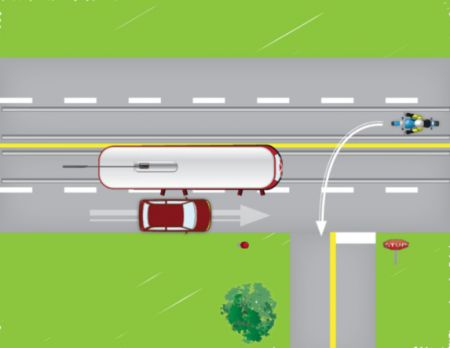Taking responsibility. When directed at motorcyclists, these dirty little words can provoke some of the most pessimistic, anecdote laced tirades this side of a model comparison debate.
I have a theory as to why.
There’s a process of acculturation in becoming a motorcyclist. Regardless of the sub-group you affiliate with, the inherent mystique and rebellious quality surrounding the lifestyle can permeate the general attitude we take with us to the streets. The two wheeled essence of our individuality turned double-edged sword when we’re not careful. Part of the problem is that it’s difficult for riders to adopt an objective state of mind regarding their road sharing responsibilities. This doesn’t mean that drivers are exempt in any way, but the fact is (like it or not) that we are more vulnerable than most road users. Tick the obvious box… I know, but many riders have trouble accepting that their increased vulnerability necessitates taking greater-than-average responsibility for themselves. Here’s a real world example to help illustrate what I’m talking about:
 In this scenario a left turning motorcyclist makes immediate eye contact with the operator of a streetcar, having just stopped to disembark passengers. The operator positively waves the rider through to complete a turn ahead of the waiting streetcar. Despite an impaired line of sight, the motorcyclist proceeds on the operator’s invitation. Unbeknownst to the rider and the transit driver, a vehicle has illegally proceeded past the open doors of the streetcar.
In this scenario a left turning motorcyclist makes immediate eye contact with the operator of a streetcar, having just stopped to disembark passengers. The operator positively waves the rider through to complete a turn ahead of the waiting streetcar. Despite an impaired line of sight, the motorcyclist proceeds on the operator’s invitation. Unbeknownst to the rider and the transit driver, a vehicle has illegally proceeded past the open doors of the streetcar.
Who’s at fault and, more to the point, who’s responsible? Beyond anything else, this scenario demonstrates that fault and responsibility are not so easily painted with the same brush. Surely fault lies with the negligent driver, but who is ultimately responsible? Despite the best intentions of the transit operator, the motorcyclist proceeded into a blind maneouvre assuming the coast was clear. Considering how tragic the outcome could have been for the rider, how little comfort would be found in knowing “it was the other guy’s fault”.
Bandying around terms like liability, fault and culpability after the fact are little more than attempts to black or white stroke a stubbornly grey canvas. Once the debris has been cleared, the insurance settlements brokered, and the legal consequences doled out… riders involved in single or multi vehicle incidents are left to cope with the trauma of the experience years after the fact.
The best approach to managing ourselves on the roads is to fine-tune our attitudes towards a more holistic worldview of road sharing with a view to minimizing as much risk as possible. More often than not this means checking our egos and any sense of entitlement at the door before heading out. It also means looking at your ridership as a whole package, one that’s shaped by every choice you make. Do you treat the morning commute on your bike the same as you do in your car? If every bit of your bike is sporting the latest “dark matte” colour scheme, are you at least wearing some hi-vis gear? Do you tend to find yourself caught unaware in vehicle blind spots on the highway? Is your riding style aggressive, hesitant or assured?
At the end of the day drivers are not our enemies and, believe it or not, they’re not out to kill us. Most drivers would readily acknowledge that, as road users, motorcyclists are indeed a vulnerable bunch. Unfortunately that goodwill can only extend so far because the majority of drivers will never appreciate what it feels like to experience that vulnerability day after day. Because of that it’s up to us to balance our expectations as general users of the road while accepting more responsibility for ourselves when we choose to ride a motorcycle.







join the conversation